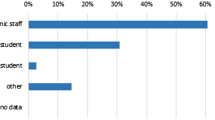Abstract
Purpose
We describe the decision drivers, development and implementation of an integrated mobile situational awareness application for the perioperative environment. This digital operating room tool for anesthesiologists facilitates direct supervision of in-room staff without requiring being tied to a stationary computer workstation.
Methods
The iOS platform was used to create the VigiVUTM mobile application at Vanderbilt University Medical Center. The first working version was completed in 3 weeks with a scalable application for department-wide distribution requiring less than 1,000 development hours.
Results
The VigiVUTM application provides situational awareness via access to real time operating room video, patient vital signs, anesthetic interventions, OR management visualization tools, patient data protection, bidirectional voice and text communication, and integrated electronic medical record access. The application allows anesthesiologists to know the status of their patients in up to four locations simultaneously. The application provides the ability to visually follow the flow of patients through the operative suite and prioritize which patients need attention. The application provides a consistent user environment on several compatible iOS devices. A group of 40 beta testers has consistently used and maintained their copy of the application, suggesting user acceptance.
Conclusions
We have demonstrated that it is possible to develop and implement an integrated mobile situational awareness application at a large academic medical center. Future research may determine whether perioperative deployment and utilization of VigiVUTM at our institution enhances patient safety and/or operating room efficiency.
Similar content being viewed by others
Abbreviations
- VigiVU :
-
A hand-held; iPhone-based version of a desktop situational awareness, operating room monitoring (VigilanceTM), that has been in use at Vanderbilt University Medical Center since 2004
- UDID :
-
Unique Device ID is a unique identifier for every iPhone, iPod Touch, and iPad
- AIMS :
-
Anesthesiology Information Management Systems
- OR :
-
Operating Room
- iOS :
-
Apple’s mobile operating system; formerly known as iPhone Operating System
- PCs :
-
Personal computers
- PHI :
-
Protected health information
- EMR :
-
Electronic medical record
- VPIMS :
-
Vanderbilt Perioperative Information Management System
- VUMC :
-
Vanderbilt University Medical Center
- CRNA :
-
Certified Registered Nurse Anesthetist
- SRNA :
-
Student Registered Nurse Anesthetist
- VOIP :
-
Voice over internet protocol
- VPN :
-
Virtual private network
- HL7 :
-
HL7 (Health Level 7, Inc., Ann Arbor, Michigan) is a collaborative international standard for the exchange, management, and integration of electronic health care information for more effective and efficient delivery. HL7 data focus on high level application layer protocols and consider the lower layers merely as tools
References
Wright MC, Taekman JM, Endsley MR (2004) Objective measures of situation awareness in a simulated medical environment. Qual Saf Health Care 13(Suppl 1): i65–i71
Endsley MR (2000) Theoretical underpinings of situation awareness: a critical review. In: Endsley MR (ed) Situation awareness analysis and measurement. CRC Press, Baco Raton, pp 1–24
Kheterpal S et al (2009) Seventh and eighth year follow-up on workforce and finances of the United States anesthesiology training programs: 2007 and 2008. Anesth Analg 109(3): 897–899
Sandberg WS (2009) Barbarians at the gate. Anesth Analg 109(3): 695–699
Blumenthal D, Tavenner M (2010) The “meaningful use” regulation for electronic health records. N Engl J Med 363(6): 501–504
Egger Halbeis CB et al (2008) Adoption of anesthesia information management systems by academic departments in the United States. Anesth Analg 107(4): 1323–1329
St Jacques P, Rothman B (2011) Enhancing point of care vigilance using computers. Anesthesiol Clin 29(3): 505–519
Wanderer JP, Sandberg WS, Ehrenfeld JM (2011) Real-time alerts and reminders using information systems. Anesthesiol Clin 29(3): 389–396
Sandberg WS et al (2008) Real-time checking of electronic anesthesia records for documentation errors and automatically text messaging clinicians improves quality of documentation. Anesth Analg 106(1):192–201 (table of contents)
Ehrenfeld JM et al (2011) Automatic notifications mediated by anesthesia information management systems reduce the frequency of prolonged gaps in blood pressure documentation. Anesth Analg 113(2): 356–363
Sandberg WS et al (2005) Automatic detection and notification of “wrong patient-wrong location” errors in the operating room. Surg Innov 12(3): 253–260
Kheterpal S et al (2007) Electronic reminders improve procedure documentation compliance and professional fee reimbursement. Anesth Analg 104(3): 592–597
Spring SF et al (2007) Automated documentation error detection and notification improves anesthesia billing performance. Anesthesiology 106: 157–163
Sandberg WS (2008) Anesthesia information management systems: almost there. Anesth Analg 107(4): 1100–1102
Juniper Networks (2012) 2011 Mobile threats report. http://www.juniper.net/us/en/local/pdf/additional-resources/jnpr-2011-mobilethreats-report.pdf
Epstein RH et al (2009) Implications of event entry latency on anesthesia information management decision support systems. Anesth Analg 108(3): 941–947
Ledolter J, Dexter F, Epstein RH (2011) Analysis of variance of communication latencies in anesthesia: comparing means of multiple log-normal distributions. Anesth Analg 113(4): 888–896
Author information
Authors and Affiliations
Corresponding author
Rights and permissions
About this article
Cite this article
Lane, J.S., Sandberg, W.S. & Rothman, B. Development and implementation of an integrated mobile situational awareness iPhone application VigiVUTM at an academic medical center. Int J CARS 7, 721–735 (2012). https://doi.org/10.1007/s11548-012-0683-8
Received:
Accepted:
Published:
Issue Date:
DOI: https://doi.org/10.1007/s11548-012-0683-8




